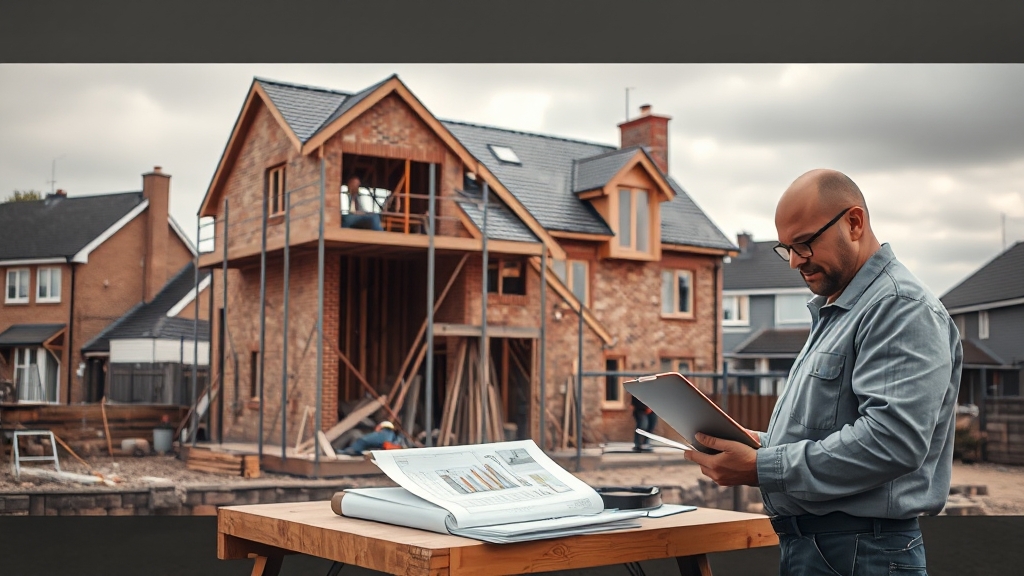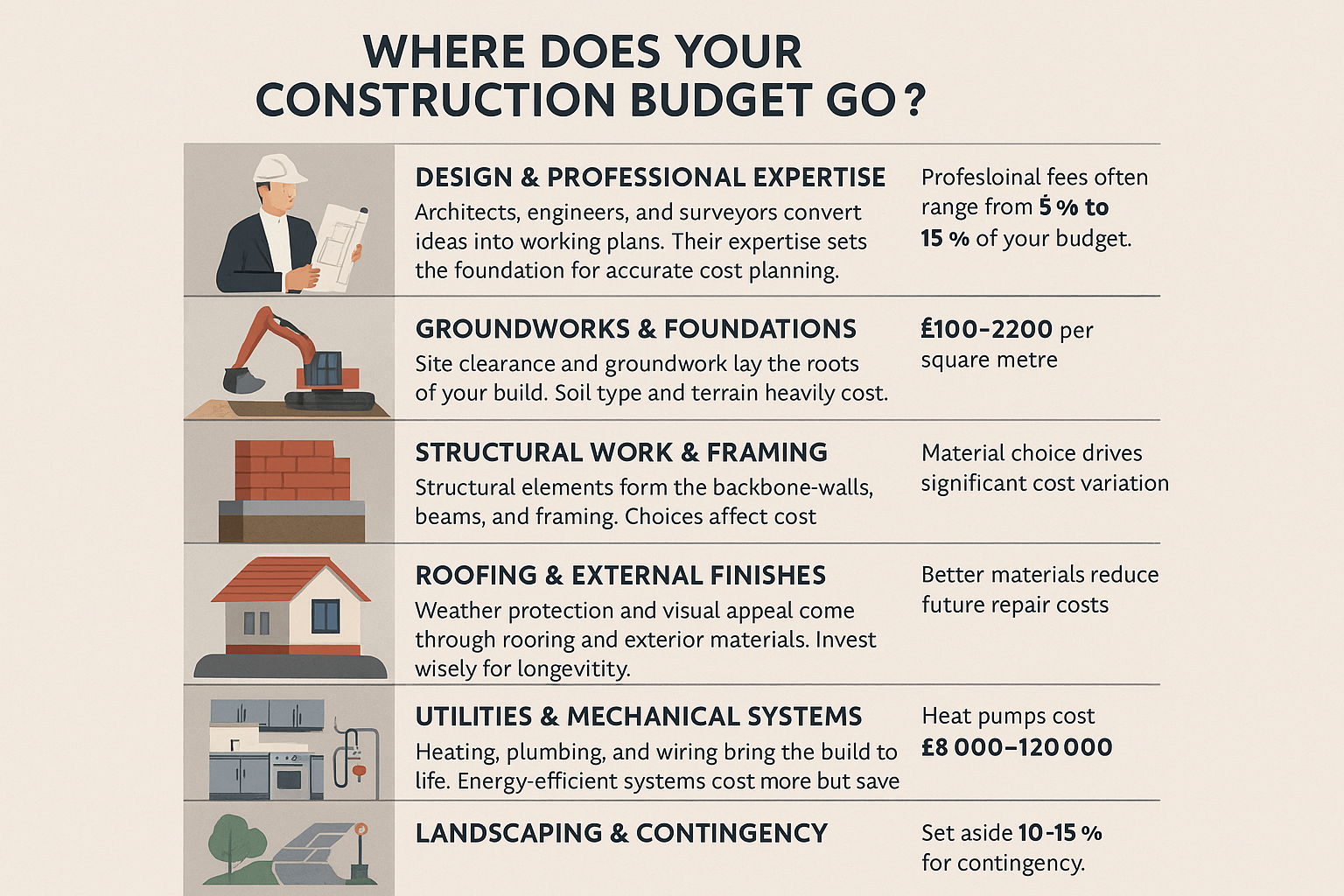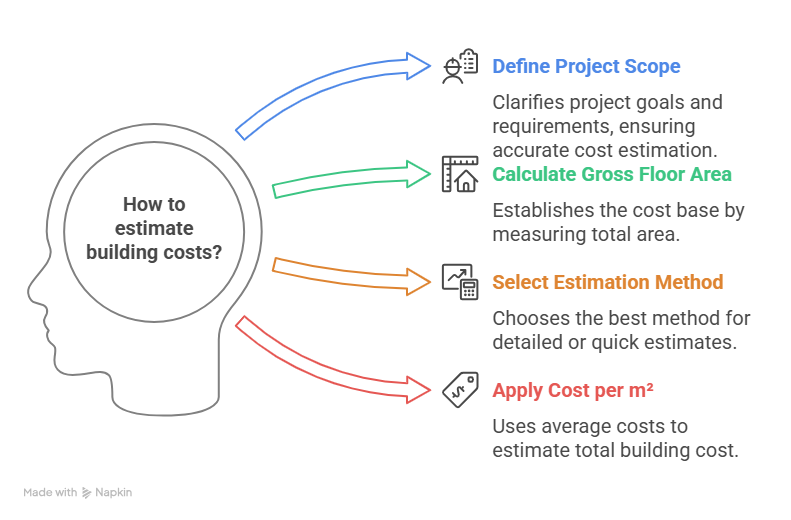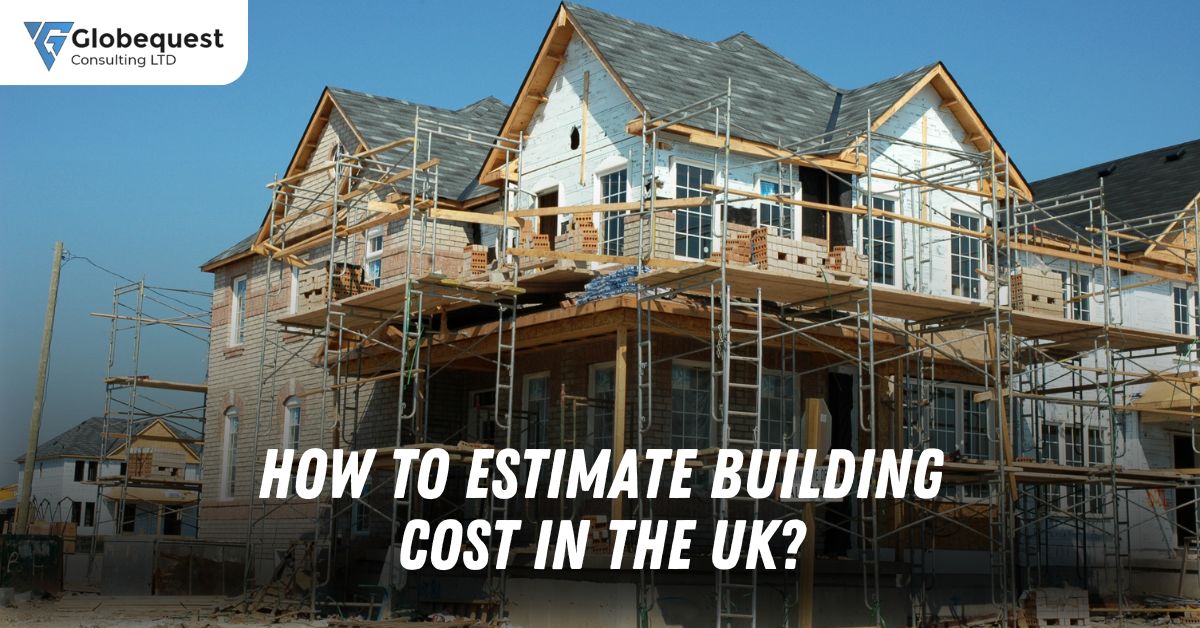Building a home, extension, or office in the UK? It’s an exciting journey, yet building costs can often feel like a maze. For instance, whether you’re a homeowner dreaming of a cosy 3-bedroom house or a contractor budgeting a commercial project, knowing how to estimate building costs in the UK is key to staying on track.
Currently, in 2025, with rising material prices and new regulations, getting an accurate building cost estimate is increasingly crucial. That’s why this guide breaks down estimating building costs in the UK step-by-step, providing the latest data, tools, and tips to help you plan like a pro. Now, let’s dive in and make budgeting far less stressful!

Introduction to Building Cost Estimation in the UK (2025)
Ever wondered what it takes to budget a UK build without surprises? Accurate estimating building costs is undoubtedly the backbone of any successful construction project, effectively saving you from budget overruns and delays. For instance, in 2025, estimating building costs in the UK means carefully navigating material price hikes, regional differences, and eco-friendly regulations.
That’s why this guide is for everyone: homeowners planning a self-build, contractors bidding on jobs, or developers eyeing commercial projects. Specifically, we’ll cover what drives construction costs, how to calculate them, and practical ways to save, all tailored for the UK market. So, ready to crunch the numbers? Now, let’s get started!
Key Factors Influencing Building Costs in the UK
Why do project budgets vary so much? Several factors shape your cost planning in construction, and therefore, understanding them greatly helps you plan smarter. For instance, here’s what to watch for:
|
Factors |
Details | Typical Cost Impact (2025) |
|
Property Size & Layout |
Typically, larger builds cost more; moreover, complex layouts like open-plan designs increase material and labour needs. | 10–20% on the overall cost for complex designs |
|
Type of Construction |
Cost plan in construction often varies by project, such as new builds, extensions, or renovations. | New Build: £1,800–£3,600/m² Extension: £1,800–£2,800/m² Renovation: £1,200–£2,400/m² |
| Material Selection | Premium or eco-friendly materials increase total spend compared to budget options. |
Bricks: £500–£1,500/1,000 units |
| Labour Costs | Skilled trades are always essential; however, rates vary by skill level and region. |
Bricklayers: £280–£400/day |
|
Planning Permission |
Drawings, applications, and approvals add fixed and professional costs. |
Fees: £578–£648 |
| Site Accessibility | Hard-to-access or remote sites raise logistics and setup costs. |
£5,000–£15,000 depending on site constraints |
Average Building Costs Per Square Metre in the UK (2025 Update)
How much does it cost to build per m² in the UK? RICS building costs per square metre in the UK vary significantly depending on the type of project and regional location. To give you a clearer picture, here’s a breakdown, sourced from BCIS and RICS.
|
Project Type |
Standard Build (£/m²) | Mid-Range Build (£/m²) | High-End Build (£/m²) |
|
New Build (Residential) |
1,800–2,400 | 2,400–3,000 |
3,000–4,600 |
|
Extension (Single-Storey) |
1,800–2,200 | 2,200–2,800 | 2,800–3,600 |
| Renovation | 1,200–1,800 | 1,800–2,400 |
2,400–3,600 |
|
Commercial (Office) |
2,000–2,800 | 2,800–3,600 |
3,600–5,000 |
| External Structures (Garage) |
800–1,200 |
1,200–1,800 |
1,800–2,500 |
Regional Variations:
- London/South East: £2,300–£4,133/m² (high labour rates).
- Midlands: £1,600–£2,400/m² (balanced market).
- North England: £1,200–£2,000/m² (lower costs).
- Scotland: £1,400–£2,200/m² (urban/rural split).
- Wales: £1,300–£2,100/m² (similar to North).
For example, the average cost to build a 3-bed house UK (100m²) is £180,000–£300,000, while the average cost to build a 4-bedroom house UK (150m²) runs £270,000–£450,000, excluding land and fees. These figures help plan your average cost to build a house uk.
Breakdown of Construction Cost Components

Where does your budget vanish in a build? Grasping building costs is like solving a puzzle; each piece shapes the final picture. To begin with, estimating building costs means breaking the process into core components, which in turn helps you craft a solid cost plan in construction. By doing so, you gain better control over your financial strategy. Furthermore, by understanding these elements theoretically, you can budget smarter and dodge surprises. So, let’s unpack the key parts driving construction costs in a UK project.
Design and Professional Expertise
Your project starts with a vision. From there, architects, engineers, and quantity surveyors turn ideas into actionable plans, ensuring both functionality and safety. These experts are vital for cost planning in construction, as they set costs based on the project scope, often running into thousands for more complex designs. As a result, their work lays the foundation for accurate building costs, aligning your dreams with reality.
Groundworks and Foundations
Groundworks are your building’s roots, involving site preparation and foundations. At this stage, expenses typically range from £100 to £200 per square metre, though they can vary based on soil conditions or terrain complexity. Because of this, estimating building costs early is essential, as it accounts for site-specific needs. Ultimately, this helps keep your budget grounded and realistic from the start.
Structural Work and Framing
The structural walls, beams, and frames give your build its shape. At this point, choices like brick or timber balance cost and style, with expenses varying widely. In many cases, this step highlights how construction costs weigh durability against budget. Consequently, it plays a key role in guiding material decisions that align with both structural needs and financial goals.
Roofing and External Finishes
Roofs and finishes shield your build from the unpredictable UK weather. In particular, finishing materials like tiles or cladding enhance both the appearance and durability of a home, with prices reflecting their quality. Therefore, it’s important to weigh initial costs against the long-term benefits they offer. Over time, investing in higher-quality finishes can lead to fewer repairs and better performance.
Internal Fittings and Finishes
Kitchens, bathrooms, and flooring make interior spaces truly livable. For instance, kitchen costs ranging from £10,000 to £30,000 often reflect the quality of materials and fittings chosen. At this stage, the estimation of construction costs directly connects with the lifestyle preferences of the client, ensuring comfort and practicality align with budget expectations.
Utilities and Mechanical Installations
Plumbing, electrical, and heating systems (e.g., heat pumps at £8,000–£12,000) bring essential functionality to your build. As such, planning these systems carefully ensures construction costs also support long-term sustainability. In the end, this proactive approach balances performance with efficiency.
Landscaping and Contingency
Driveways and gardens add the finishing touches to your project, while a 10–15% contingency is equally important, covering surprises. Together, both elements play a crucial role in developing a comprehensive construction cost plan. Without them, your budget could miss key final details or unforeseen issues.
Step-by-Step Guide to Estimating Building Costs
Ready to estimate the building cost for your project? Follow this 7-step guide to get a solid budget, whether it’s a house or an office:

- Define Project Scope and Requirements: Outline your goals, say, a 3-bedroom house, 100m², mid-range finish. Specify a new build or extension.
- Calculate Gross Floor Area: Measure total area (e.g., 100m²) using plans or a site survey. This sets your cost base.
- Select Estimation Method: Try the centerline method (detailed, great for brick structures) or the trade method for quick estimates.
- Apply Cost per m²: Use averages from Section 3 (e.g., £2,400/m² for mid-range new build). For 100m², that’s £240,000.
- Adjust for Location and Inflation: Add 20% for London, subtract 10% for the North. Factor in 2–3% inflation for 2025.
- Factor in Additional Costs: Include land (£100,000–£1,000,000), fees (£5,000–£20,000), permits (£578–£648), and utilities (£5,000–£30,000).
- Add Contingency and Validate: Budget 10–15% extra (£24,000–£36,000 for £240,000). Get quotes from contractors to confirm.
Residential vs. Commercial Cost Estimation
What’s the difference when estimating building costs in the UK for homes versus offices?
|
Residential Cost Estimation |
Commercial Cost Estimation |
|
Focuses on aesthetics and comfort (e.g., stylish kitchens, cosy bedrooms). |
Prioritises functionality and durability (e.g., robust systems, open layouts). |
|
Costs are driven by custom finishes (e.g., hardwood floors, bespoke fixtures). |
Costs tied to scale and compliance (e.g., fire safety, accessibility features). |
| Smaller-scale, personal projects (e.g., 3-bedroom house). |
Larger, high-use spaces (e.g., offices, retail units). |
| Flexible regulations for personal use. |
Stricter UK standards for public safety. |
| Extras like gardens add charm but increase budgets. |
Systems like HVAC dominate, pushing costs higher. |
Tools and Methods for Accurate Cost Estimation
How do you nail your building cost estimate? The right tools make all the difference. Here’s what’s available in 2025:
Manual Methods:
- Centerline Method: For instance, ideal for brick structures, calculates wall lengths and volumes (see Where Is The North’s approach). Great for detailed estimates, but time-consuming.
- Spreadsheets: While free, they are error-prone for complex projects. Use for small builds (<50m²).
Cost Estimating Software:
- HBXL: Integrates with UK price books, costs £500–£1,500/year. Thus, perfect for contractors.
- EstimatorXpress: User-friendly, £600–£1,200/year. Hence, great for small firms.
- Buildxact: Cloud-based, £1,000–£2,000/year, including bid creation and tracking.
Online Cost Calculators:
- Specifically, free tools like RICS building costs per square metre UK guides offer quick estimates (e.g., input 100m², get £180,000–£300,000).
Quantity Surveyors:
- Cost: £1,000–£5,000, yet saves 5–10% by catching errors. Therefore, MRICS-certified pros ensure accuracy.
Understanding UK Building Regulations and Compliance Costs
UK regulations can bump up your construction costs, but they’re non-negotiable. Here’s what to know for 2025:
Role of Building Control:
It ensures safety and compliance with standards like Part L (energy efficiency). Inspections cost £500–£2,000.
Permit Costs:
- Planning permission: £578–£648 in England, per gov.uk.
- Building control approval: £300–£1,200, depending on project size.
2025 Energy Regulations:
- Mandate low-carbon heating (e.g., air source heat pumps at £8,000–£12,000).
- Require better insulation (£20–£50/m² for eco-friendly options).
- Add £5,000–£15,000 to meet Part L standards, per RICS.
Compliance Tips:
- Hire a building control officer early to avoid rework.
- Budget for certifications (e.g., EPC at £100–£300).
Sustainability and Cost Considerations for building a cost estimator.
Going green isn’t just good for the planet, it can save you money long-term. Here’s how estimating building costs for eco-friendly builds works in 2025:
Eco-Friendly Materials:
- Recycled insulation: £20–£50/m² vs. £15–£30/m² for standard.
- Timber frames: £100–£200/m², a carbon-neutral alternative to steel (£150–£300/m²).
- Solar panels: £5,000–£10,000 for a 4kw system.
BREEAM/Passivhaus Standards:
- Cost: £1,500–£3,900/m², but cuts energy bills by 70%, per BREEAM.
- Example: A Passivhaus home (100m²) costs £150,000–£390,000.
Grants and Incentives:
- The Help to Build Equity Loan offers funding of up to 20% toward the total cost of building your own home in the UK.
- Boiler Upgrade Scheme: £7,500 for heat pumps, reducing upfront costs.
Tips:
- Choose modular designs to cut waste (saves 10–15%).
- Consult a sustainability expert (£500–£2,000) for grant eligibility.
Case Studies: Real UK Projects in 2025
Want to see building cost estimates in action? Here are two real-world UK projects from 2025, showing how budgets come together:
Case Study 1: 3-Bedroom House in Manchester
Details: 120m², mid-range build, suburban plot.
Cost Breakdown:
- Build: £288,000 (£2,400/m²).
- Land: £150,000.
- Fees: £10,000 (architect, surveyor).
- Utilities: £15,000.
- Contingency (10%): £28,800.
- Total: £491,800.
Outcome: Completed in 10 months, used EstimatorXpress for accuracy. Homeowner Sarah says, “The building cost estimator saved us 8%!”
Note: The average cost to build a 3-bed house in the UK aligns with this at £240,000–£360,000 for 100–120m².
Case Study 2: Commercial Office Extension in London
Details: 200m² single-storey, high-spec.
Cost Breakdown:
- Build: £720,000 (£3,600/m²).
- Fees: £20,000.
- Permits: £1,200.
- External Works: £50,000.
- Contingency (12%): £86,400.
- Total: £877,600.
Outcome: BREEAM-compliant, used a quantity surveyor for precision.
How to Minimise Costs Without Sacrificing Quality
Who doesn’t want to save on construction costs? Here’s how to trim your budget without cutting corners:
Smart Material Choices:
- Use engineered wood (£50/m²) over hardwood (£100/m²) for floors.
- Opt for modular walls to cut labour costs by 10–15%.
Efficient Project Planning:
- Planning construction for the spring can help minimise weather-related setbacks and reduce costs by 5–10%
- Use software like Buildxact (£1,000–£2,000/year) to streamline tasks.
- Effective cost planning in construction prevents overruns!
Work with Quantity Surveyors:
- Cost: £1,000–£5,000, but spot savings (e.g., bulk material discounts).
- MRICS pros ensure budgets stay tight, per RICS standards.
Tips:
- Get multiple contractor quotes (3–5) to compare rates.
- Negotiate fixed-price contracts to avoid surprises.
Common Mistakes to Avoid When Estimating Costs
Budget slip-ups can derail your build. Avoid these common mistakes when calculating your building expenses:
- Underestimating Scope: Missing items like landscaping add 10–20%. Always list every element, from fences to fittings.
- Be aware of seasonal change: Material prices often rise by 3–5% during the summer months. Plan purchases in off-peak seasons (e.g., winter).
- Don’t overlook VAT and professional fees: while new builds are zero-rated for VAT, renovations usually attract a 20% charge. Budget £5,000–£20,000 for fees (e.g., architects, permits).
- Skipping Contingency: Without a 10–15% buffer, site issues (e.g., poor soil) can bust your budget.
- Relying on Generic Estimates: Online calculators are a start, but quotes from local contractors are more accurate.
Building Cost Estimate: Key Takeaways for Smarter Planning
When estimating building costs in the UK, it’s important to understand the factors that affect expenses. Factors like location, choice of materials, labour costs, and the overall scale of the project all influence the total build cost. Whether building a new home or extending an existing one, getting an early estimate can help you avoid costly surprises.
Many homeowners and developers use the RICS building costs per square metre UK as a trusted benchmark. This guide offers average costs for different building types and regions, helping you create a more accurate financial plan. It also lets you compare your project costs to national averages and adjust as needed.
For a more detailed building cost estimate, it’s best to consult a professional. These resources factor in project specifics like design complexity and site conditions, giving you a more realistic figure. Careful cost planning is key to a successful construction project.
FAQS: Cost Estimation for Building Projects in the UK
How to calculate an estimate for a building?
Use the centerline method for detailed budgets or software like Buildxact for speed. Factor in materials (£500–£1,500/m²) and labour (£280–£400/day).
How much does it cost to build per m² in the UK?
In 2025, construction costs per m² UK average £1,800–£3,600 for new builds, £1,200–£2,800 for renovations, per BCIS.
What is the average building cost per square metre in the UK?
Mid-range new builds hit £2,400/m², while high-end projects reach £4,600/m² in London.
How to estimate a build cost in the UK?
Estimating building costs in the UK is simple with our 7-step guide in Section 5. Define your project, measure area, apply costs, and add fees for a solid building cost estimate.
How to estimate the building cost of a house?
For a 100m² house, multiply area by £1,800–£3,600/m², add land (£100,000–£1,000,000), and fees (£5,000–£20,000).
Do I need a quantity surveyor?
For projects over £100,000, they save 5–10% by spotting errors, costing £1,000–£5,000.
Are self-builds cheaper than buying?
Self-builds save 20–30% vs. developer homes but need careful planning.



